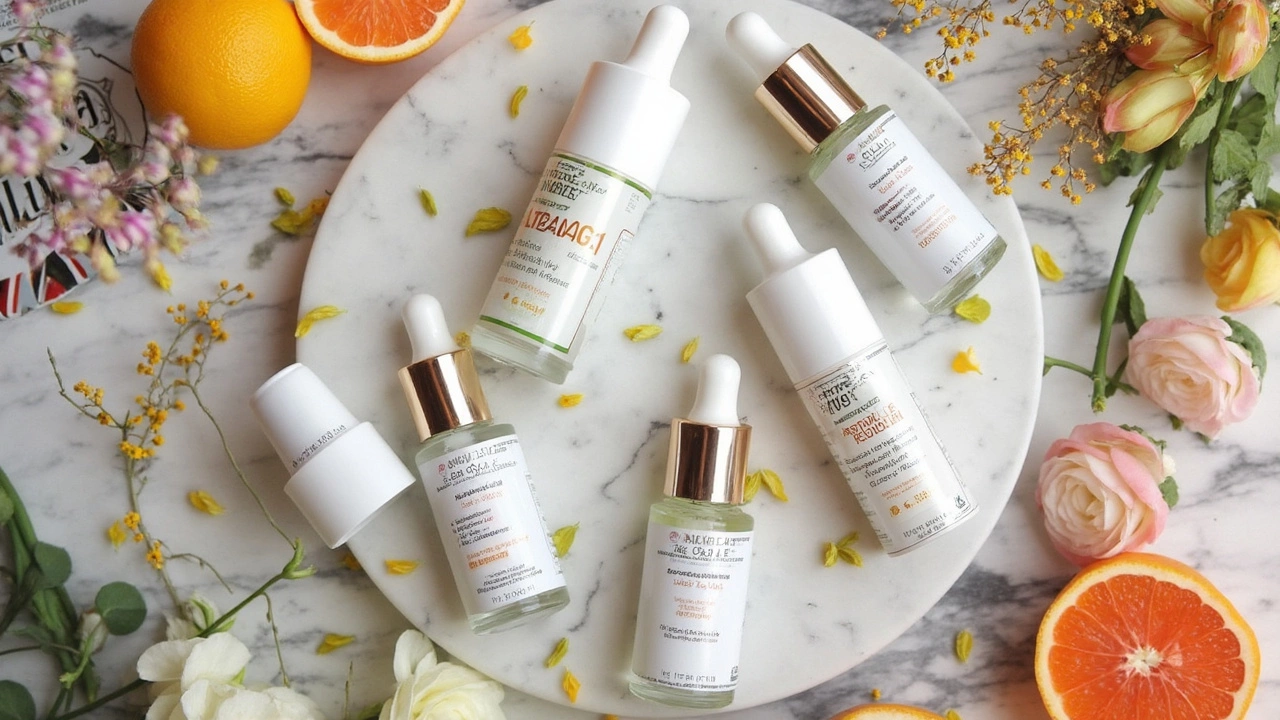Wish your skin was smoother, brighter, or just less moody? That’s where face serums show up—right between cleansing and moisturizer, packing a punch of active ingredients in just a few drops. No, it’s not just beauty industry hype. Serums are lighter than creams and can deliver targeted ingredients straight to your skin, making a real difference when picked wisely.
There’s a serum for pretty much every skin goal—whether you’re tired of dullness, want to shrink those fine lines, or just crave a boost of hydration that doesn’t turn greasy. The key? Knowing what’s in the bottle and what it can do. Some ingredients like vitamin C or hyaluronic acid aren’t just buzzwords; they’re backed by science and actually change the way your skin behaves over time.
If you’re standing in front of a confusing shelf of fancy bottles, you’re not alone. I’ve been there too, and trust me, a handful of hardworking serums can really cut through the clutter. Ready to see real results without wasting money? Let’s get into what works and why it matters.
- Why Face Serums Make a Difference
- How to Choose: Ingredients That Actually Work
- The Top 5 Face Serums Right Now
- How to Layer Serums with Other Products
- Simple Tips for Better Results
- Serum Myths That Need Busting
Why Face Serums Make a Difference
There’s a reason so many skincare experts talk about serums. These little bottles pack higher amounts of active ingredients than most creams or lotions, so you get real changes much faster. Unlike moisturizers that just sit on top of your skin, serums soak in deep because they’re made with smaller molecules. That means ingredients like vitamin C, hyaluronic acid, and niacinamide can actually reach where they need to go.
Think of your skincare routine like making a sandwich: cleansers get rid of old crumbs, serums add the toppings with benefits, and moisturizers keep everything together. It doesn’t matter if your skin is oily, dry, or changing with the seasons—there’s a serum out there for you. Dermatologists always point out that consistent use of the right serum can show visible improvements in a month or two. For example, studies show 70–80% of people see brighter skin after using vitamin C serum for 8 weeks.
- Instant boost: Some serums start working in hours—think hyaluronic acid for plumper skin.
- Target specific issues: Whether it’s dullness, aging, or dark spots, there’s a formula for that.
- Works for everyone: All ages and skin types can include a serum to their routine.
| Serum Benefit | Time to See Results |
|---|---|
| Hydration (Hyaluronic Acid) | Within 24 hours |
| Brightening (Vitamin C) | 4–8 weeks |
| Wrinkle Reduction (Retinol) | 8–12 weeks |
| Pore Improvement (Niacinamide) | 2–4 weeks |
If you’re looking to get the best out of your face serums, just remember—they’re not magic potions, but when you use them right, they really do make a difference. The payoff comes from picking the right one and sticking with it. Your skin will thank you before you know it.
How to Choose: Ingredients That Actually Work
Picking the right face serum can feel like decoding a mystery. Fancy packaging and buzzwords don’t mean much if the formula doesn’t have ingredients that truly do something for your skin. It’s all about knowing what does what and matching that to your skin goals.
Here are the top ingredients you’ll want to look for in a face serum—and what they’re actually good for:
- Vitamin C: Great for brightening and fighting spots. If you have dullness or pigmentation, serums with Vitamin C (look for L-ascorbic acid at 10-20%) are a good bet. A lot of people start seeing results—like a fresher glow— in as little as four weeks.
- Hyaluronic Acid: If dryness is your big issue, this one hydrates like nothing else. It can hold up to 1,000 times its weight in water, turning rough and thirsty skin into something you actually want to touch.
- Niacinamide: Calms redness, shrinks the look of pores, and even makes skin less oily. If you have sensitive skin or deal with breakouts, niacinamide at 5% usually does the trick without irritation.
- Retinol (Vitamin A): The gold standard for fine lines, uneven skin, and texture. Retinol can be a little intense at first, so start slow and look for lower percentages (like 0.3-0.5%) if you’re new. You’ll likely see smoother, firmer skin after a couple months.
- Peptides: These help plump up skin and boost firmness over time—especially great if you’re trying to tackle early wrinkles or maintain elasticity.
Still can’t decide? Here’s a quick guide to match what you want with what you need:
| Skin Concern | Best Ingredient |
|---|---|
| Dryness | Hyaluronic Acid |
| Dullness/Brown Spots | Vitamin C |
| Redness/Blemishes | Niacinamide |
| Fine Lines/Wrinkles | Retinol, Peptides |
| Loss of Firmness | Peptides |
Don’t ignore what’s on the label—actual percentages matter. For example, hyaluronic acid works even at 1-2%, while vitamin C serums should list L-ascorbic acid near the top of the ingredient list. The texture matters too. Water-based serums sink in fast and suit oily or combo skin; oil-based ones are friendlier for super dry or mature skin.
One more thing: always do a patch test before going all in, especially with active ingredients like retinol or vitamin C. That quick check can save you from redness and flakiness you definitely didn’t ask for.
The Top 5 Face Serums Right Now
Sorting through which face serums actually work can suck up your time and budget. Here are five that keep showing up at the top—every one of these brings something different to the table, whether you want brighter skin, smoother texture, moisture, or fewer breakouts. I dug into what makes each serum a heavy-hitter, plus when you should use them and what to expect.
- The Ordinary Niacinamide 10% + Zinc 1% – If breakouts or large pores bug you, this one is everywhere for a reason. Niacinamide helps reduce oil production and shrinks pores, while zinc calms angry skin. It’s lightweight, absorbs fast, and a 30ml bottle usually costs less than $10. Dermatologists point out that niacinamide is solid for redness too. Use in the morning or at night—just avoid mixing with vitamin C at the same time.
- La Roche-Posay Hyalu B5 Serum – Feeling parched or flakey? This one packs hyaluronic acid (pulls in water) and vitamin B5 (boosts healing). You literally get plumper, bouncier skin in about a week. Real users see fewer dry patches, especially in dry climates or winter. Works for all skin types, including sensitive.
- Skinceuticals C E Ferulic – This is the vitamin C serum that people actually use until the bottle’s empty—mainly because it’s shown in peer-reviewed studies to brighten and fight signs of aging. The combo of vitamin C, vitamin E, and ferulic acid basically blocks out free radicals from UV and pollution. It isn’t cheap (around $180), but it actually keeps skin glowy and even-toned over months. Use in the morning, right before sunscreen.
- COSRX Advanced Snail 96 Mucin Power Essence – Snail mucin sounds odd, but it’s packed with hydrating and repairing ingredients. Fans swear it helps fade scars faster and keeps skin stronger after breakouts. Since it’s lightweight, it doesn’t clog pores. This serum is especially popular in K-beauty routines, and works for pretty much anyone with irritated or stressed-out skin.
- Paula’s Choice 1% Retinol Treatment – Retinol is the go-to for smoother skin and fewer wrinkles. Paula’s Choice nails the balance between real results and less irritation than most. It fades dark spots, pushes skin to renew itself faster, and over time, makes a real difference in texture. Use only at night, start slow (once or twice per week), and always wear sunscreen in the morning since retinol can make you more sensitive to the sun.
Take a look at the cheat-sheet below for a side-by-side comparison, so you can see what fits your needs best:
| Serum Name | Main Benefit | Main Ingredient | Best For | Price (USD) | When to Use |
|---|---|---|---|---|---|
| The Ordinary Niacinamide 10% + Zinc 1% | Reduces oil, shrinks pores | Niacinamide, Zinc | Oily, acne-prone skin | 9 | AM or PM |
| La Roche-Posay Hyalu B5 | Intense hydration | Hyaluronic Acid, Vitamin B5 | Dry, sensitive skin | 40 | AM or PM |
| Skinceuticals C E Ferulic | Brightening, anti-aging | Vitamin C + E, Ferulic Acid | Aging, dullness | 180 | AM |
| COSRX Advanced Snail 96 | Healing, hydration | Snail Mucin | Sensitive, irritated skin | 22 | AM or PM |
| Paula’s Choice 1% Retinol | Smoother texture, wrinkles | Retinol | Aging, uneven texture | 62 | PM |
The results with serums aren’t instant, but most people see changes in 4–6 weeks when using them as directed. Always patch test a new product before smoothing it all over your face. And yeah, mixing too many actives at once can irritate your skin, so find what fits your top goal and start there.

How to Layer Serums with Other Products
Layering serums with other products doesn’t have to be complicated, but doing it in the right order actually makes a difference. The simple rule? Go from thinnest to thickest textures. This helps each product sink in and do its job instead of just sitting on top of your skin. Putting a thick cream before a serum can block the good stuff from getting where you want it to go.
Here’s a straightforward order most dermatologists recommend for your skincare routine:
- Cleanser – Start with clean skin. Even the best serum won’t work well on a dirty face.
- Toner (optional) – If you use one, pat it in and let it dry. Toners help remove leftover dirt and prep your skin for what’s next.
- Serum – This is where you target issues like dryness, dullness, or aging. Let your serum sink in for a minute or two before layering anything on top.
- Moisturizer – Seals in the serum, locking those ingredients in so your skin stays hydrated and smooth.
- Sunscreen (AM only) – Always finish with SPF in the morning. No serum will protect you from sun damage like a good sunscreen can.
When using more than one serum, try this:
- Apply water-based serums first, like hyaluronic acid or niacinamide.
- Wait about 60 seconds, then use oil-based or creamy serums, such as those with vitamin E or retinol.
Mixing too many actives (like vitamin C, retinol, and acids) can backfire and irritate your skin, so go slow. If you want to pair two serums with powerful ingredients, it’s smart to use one in the morning and the other at night.
Here’s a quick look at how long different products take to absorb, so you’re not left wondering if it’s time for the next step:
| Product | Average Absorption Time |
|---|---|
| Water-based serum | 30-60 seconds |
| Oil-based serum | 1-2 minutes |
| Moisturizer | 1-3 minutes |
Final tip: Don’t rub too hard. Pat serums in gently—think of it like giving your skin a little drink, not a workout. And if you ever use retinol or other strong actives, always go in with SPF during the day. Your skin will thank you.
Simple Tips for Better Results
You’ve got your face serum, but now what? Applying it the right way totally changes the game. Even the priciest serum can fall flat if it’s not used correctly. Let’s keep it simple and super practical.
- Less is more: You only need 2-3 drops, max. Slathering on more won’t boost results and just wastes money.
- Clean your skin first: If there’s dirt or leftover makeup, your serum’s just sitting on top. A quick, gentle cleanse is key before anything else touches your face.
- Apply while damp: Pat your face dry, but don’t wait too long. Serums absorb better when your skin is still a bit damp, not bone dry.
- Press, don’t rub: Use your fingertips to gently press the serum in. Rubbing can be too harsh and actually irritate sensitive skin.
- Layer smart: Always use your face serums before heavier moisturizers or oils. Think of serums as the star player—they go in right after cleansing but before creams or SPF.
- Stay consistent: No serum is a miracle overnight fix. Studies say it usually takes 4 to 8 weeks of daily use to see noticeable results.
If you want to know how fast serums work or what most people use them for, here’s a quick breakdown:
| Common Serum Benefit | Avg. Time to Notice Results |
|---|---|
| Hydration (Hyaluronic acid) | Immediate to 1 week |
| Brightening (Vitamin C) | 3 to 8 weeks |
| Anti-aging (Retinol) | 4 to 12 weeks |
If you ever get redness, burning, or peeling, don’t tough it out—give your skin a break or switch to a gentler formula. Also, always toss expired serums. Outdated ingredients don’t just stop working, they can even cause breakouts or reactions.
A final pro tip? Store vitamin C and retinol serums away from sunlight and heat. Both are sensitive and lose their punch if left on the bathroom counter. I always stash mine in a cool drawer—that way every drop works as hard as it should.
Serum Myths That Need Busting
Let’s be real, there’s a ton of confusion floating around about facial serums. Instagram makes them sound like miracle workers, while some old-school advice says you don’t need them at all. Not true. Here are some myths that could be holding back your glow-up.
- Face serums are just expensive water – False. Real serums are loaded with active ingredients like vitamin C, hyaluronic acid, or retinol. They’re not glorified water; formulations usually pack way more actives per drop than your regular moisturizer.
- Serums are only for people with problem skin – Wrong. Even if your skin is clear, you can use serums to keep it hydrated, protected, or even help your skin age slower. Prevention beats cure—always.
- One serum fits all skins – Nope. Different skin types (oily, dry, combo, sensitive) need different serum formulas. For example, a serum with niacinamide is great for oily or breakout-prone skin, while something rich in ceramides fits dry skin much better.
- Serums replace moisturizer – Not the case. Serums deliver the actives, but you still need a moisturizer to lock in the benefits and keep your skin barrier strong. It’s a team effort, not a one-man show.
- Serums work instantly – Don’t hold your breath. While your skin might feel nicer right away, most serums need around 4-8 weeks to show visible results. It’s about consistency, not quick fixes.
Still not sure what’s fact or fiction? Here’s a quick data table that highlights the reality versus the hype:
| Myth | Reality |
|---|---|
| Serums replace all other products | Serums support other products, but don’t replace cleanser or moisturizer |
| Serums are too strong for daily use | Most are designed for daily use, but always check the label for actives like retinol |
| Expensive always means better | Affordable serums with the right ingredients can be just as effective |
If you’re unsure about a new serum, do a quick patch test on your jawline or neck before slathering it all over. And if a product stings, burns, or leaves you red, that’s your cue to stop—not all serums are a fit for every face. Trust what your skin tells you, not just the hype you see online.


